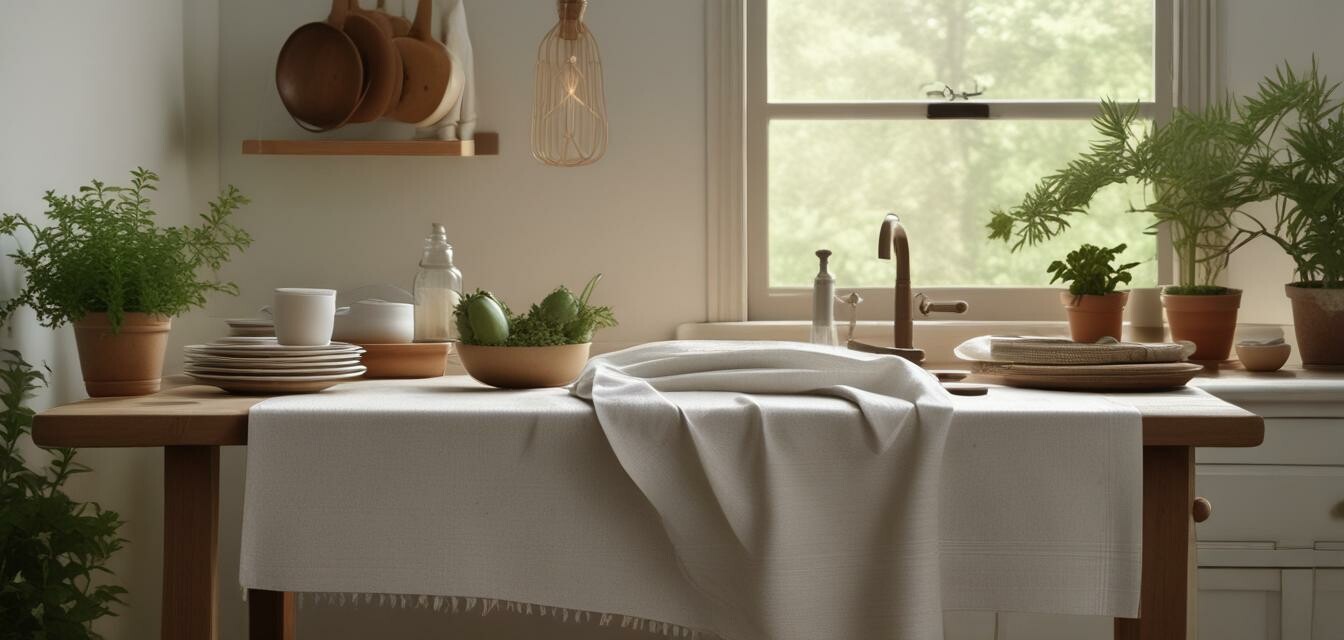
Eco-Friendly Kitchen Textiles You Need
Key Takeaways
- Choosing eco-friendly kitchen textiles reduces your environmental impact.
- Sustainable materials include organic cotton, linen, and bamboo.
- Investing in reusable textiles can save you money in the long run.
- Look for certifications like GOTS and OEKO-TEX to ensure sustainability.
- Explore a variety of products from table linens to dishcloths to enhance your kitchen.
In today's eco-conscious world, understanding the importance of sustainable kitchen textiles is vital. With so many options available, it can be challenging to navigate what to choose for your kitchen that is both functional and eco-friendly. In this guide, we will look at essential eco-friendly kitchen textiles, highlight their benefits, and provide suggestions for integrating them into your daily life.
Why choose eco-friendly kitchen textiles?
Eco-friendly kitchen textiles offer numerous benefits:
- Reduce waste: Choosing reusable over single-use products minimizes landfill contributions.
- Health benefits: Many eco-friendly textiles are free from harmful chemicals.
- Durability: High-quality materials often last longer than their conventional counterparts.
- Support sustainable practices: Purchasing these textiles encourages eco-conscious companies.
Types of eco-friendly kitchen textiles
There are several categories of eco-friendly textiles that you can incorporate into your kitchen:
| Type | Description | Materials |
|---|---|---|
| Dish Towels | Absorbent towels for drying dishes, hands, and surfaces. | Organic cotton, bamboo. |
| Tablecloths | Protect surfaces and enhance dining experiences. | Linen, hemp, recycled cotton. |
| Napkins | Reusable alternatives to paper napkins. | Organic cotton, bamboo fiber. |
| Aprons | Protect clothing while cooking and serving. | Hemp, organic cotton. |
| Pot Holders | Safety tools for handling hot pots and pans. | Recycled materials, cotton. |
Materials to look for in eco-friendly textiles
When selecting kitchen textiles, consider the following sustainable materials:
- Organic Cotton: Grown without synthetic pesticides and fertilizers, organic cotton is soft and breathable.
- Linen: Made from flax, linen is durable and naturally biodegradable.
- Bamboo: A fast-growing plant that requires minimal resources, bamboo textiles are known for their softness and antibacterial properties.
- Hemp: Extremely durable, hemp grows quickly and thrives in poor soil without the need for chemicals.
- Recycled Materials: Textiles made from recycled fabrics reduce waste and conserve resources.
How to care for your eco-friendly kitchen textiles
Caring for your sustainable kitchen textiles helps ensure their longevity:
- Washing: Use gentle, eco-friendly detergents and cold water when washing your textiles.
- Drying: Hang to dry when possible to save energy, or use a low-heat dryer setting.
- Avoid bleach: This can damage the fibers and contribute to environmental harm.
- Storage: Keep textiles in a dry place to avoid mildew, and fold neatly to maintain their shape.
Where to buy eco-friendly kitchen textiles
There are many places to shop for eco-friendly kitchen textiles, including local stores and online markets. Look for reputable retailers that prioritize sustainable products.
Supporting local businesses
Consider visiting local farmers' markets or shops that specialize in organic and sustainable goods. This way, you can support your community while shopping responsibly.
Online options
Many online retailers offer extensive selections of eco-friendly kitchen textiles for home delivery. Check reviews and product descriptions to ensure that you're purchasing high-quality, sustainable goods.
Enhancing your kitchen with eco-friendly textiles
Incorporating eco-friendly textiles into your kitchen doesn’t just benefit the environment; it also adds charm and style. Here are ways to enhance your kitchen:
- Use beautiful tablecloths to create a warm dining atmosphere.
- Choose coordinating napkins for a polished look during meals.
- Display your colorful dish towels prominently in the kitchen.
- Mix and match patterns for a fun, eclectic style.
- Invest in a stylish apron for cooking or baking days.
Conclusion
Choosing eco-friendly kitchen textiles is a great step towards creating a sustainable kitchen. With a variety of materials and options available, you can easily find textiles that suit your style and values. Start by replacing your conventional items with these sustainable options and enjoy the benefits they bring to your kitchen and the environment.
Pros
- Reduces environmental impact.
- Provides health benefits by avoiding harmful chemicals.
- Cost-effective in the long run due to durability.
- Supports ethical manufacturers.
Cons
- Initial investment may be higher than regular textiles.
- Availability may vary by location.
- Some eco-friendly materials may require special care.
For additional tips on making your kitchen more sustainable, check out our guides on buying guides or explore sustainable bamboo kitchenware options.
Browse our collection of compostable kitchen tools and eco-friendly storage solutions to further enhance your eco-friendly kitchen.



